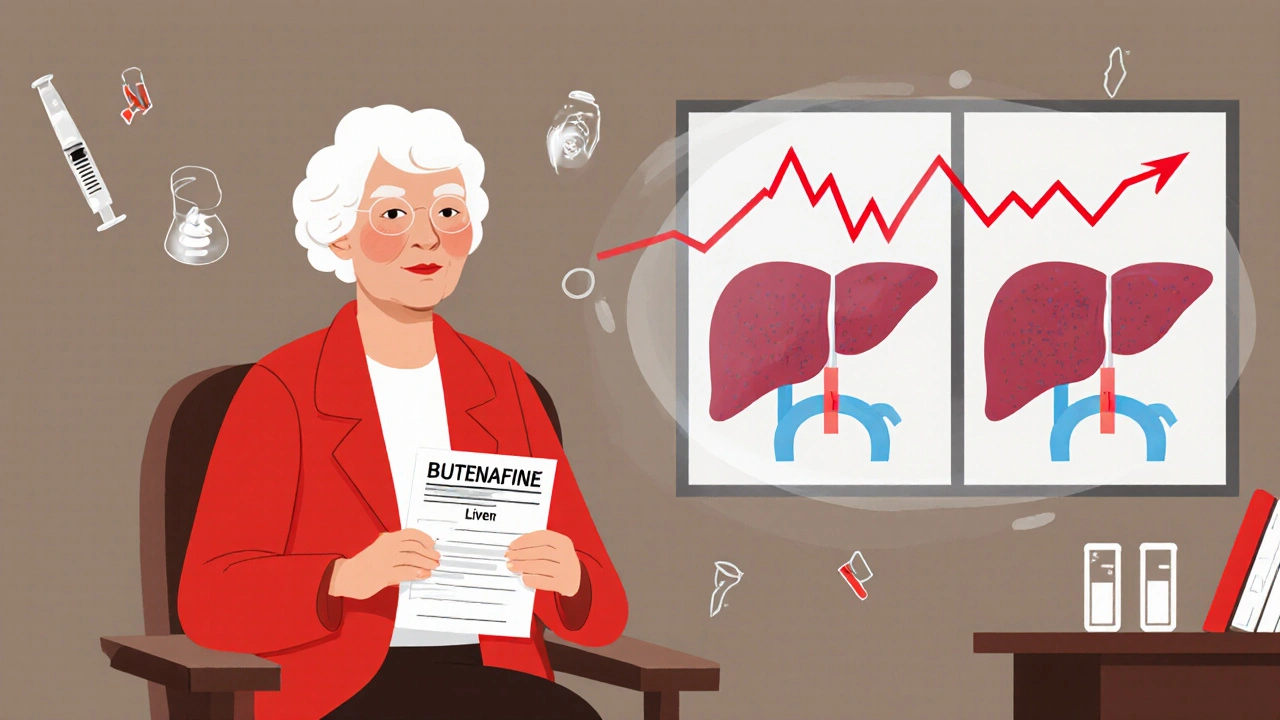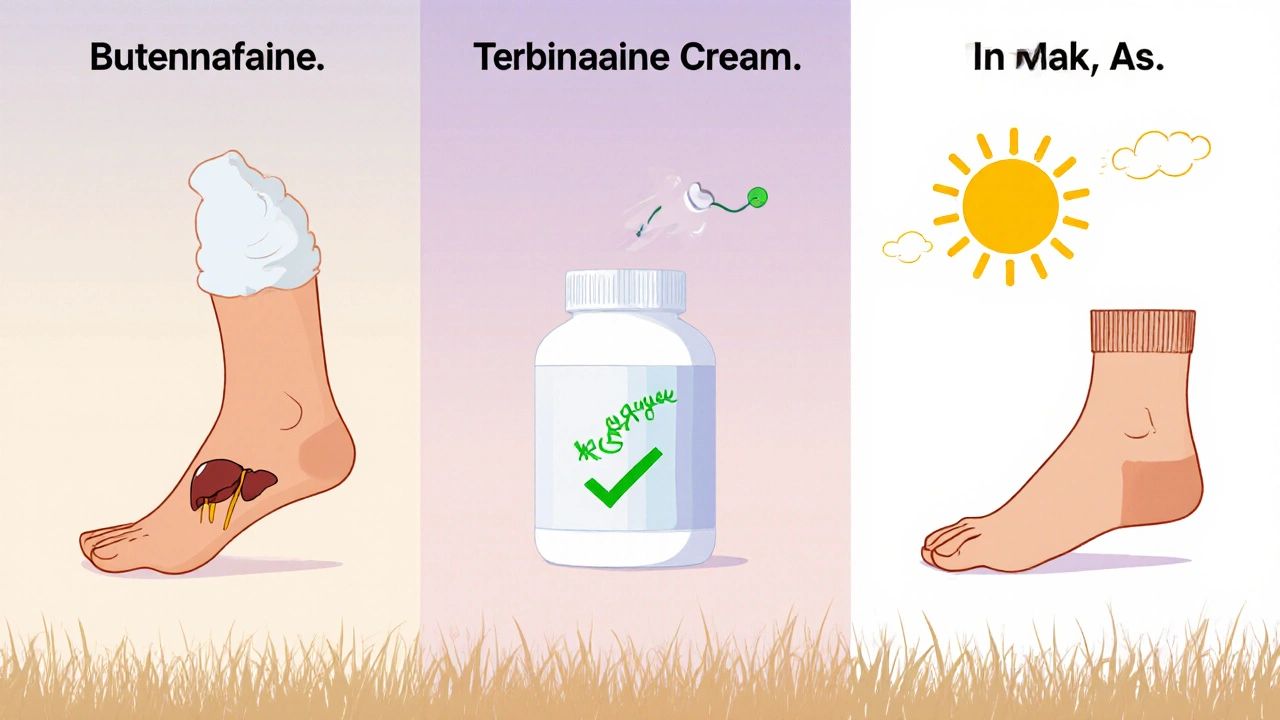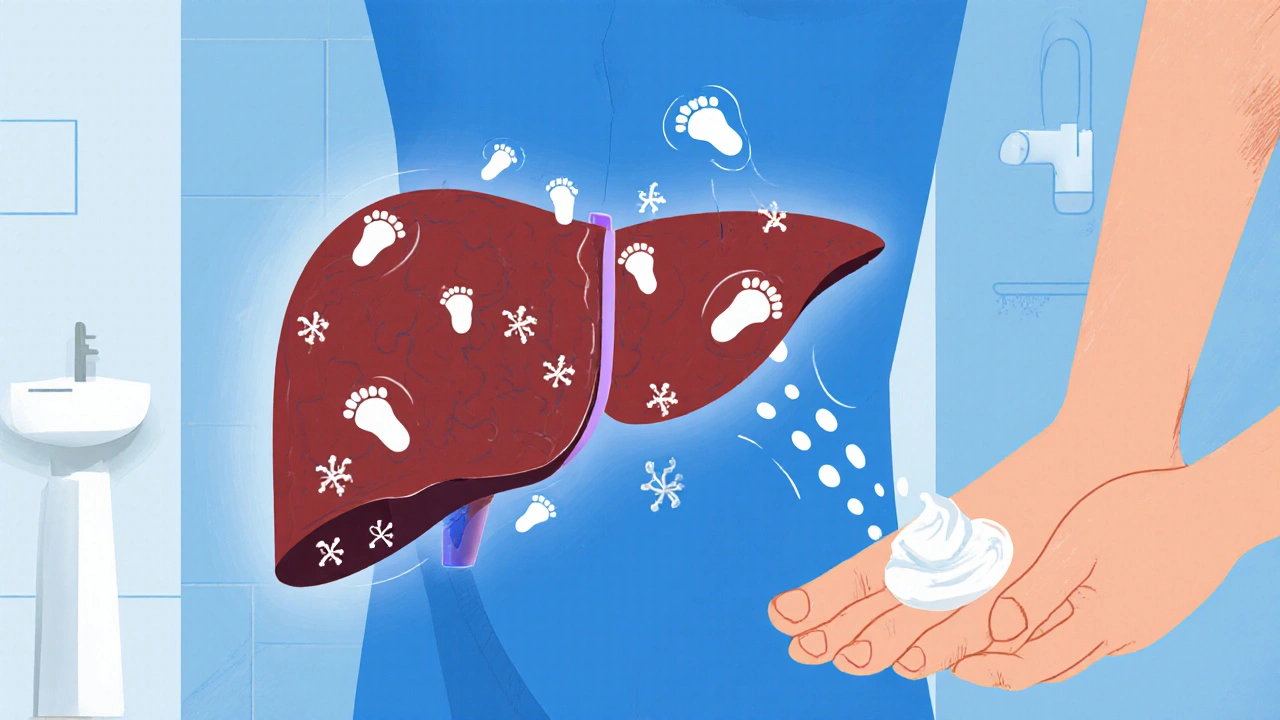Most people take butenafine without thinking twice. It’s an antifungal cream used for athlete’s foot, jock itch, and ringworm-common, annoying skin issues. But if you’re taking it long-term, have existing liver problems, or are on other meds, you might be wondering: butenafine and liver health-do they connect?
What is butenafine, really?
Butenafine is a topical antifungal. That means it’s applied to the skin, not swallowed. It works by stopping fungi from building their cell membranes. Without that structure, the fungi die. It’s sold under brand names like Mentax and Naftin. The key point? It’s designed to stay on the skin. Less than 1% of the applied dose gets absorbed into your bloodstream.
In clinical trials, less than 0.5% of users reported any systemic side effects. That’s why most doctors treat it like a low-risk treatment. But low risk doesn’t mean no risk. And when it comes to your liver, even small amounts can matter.
Does butenafine reach your liver?
Yes-but barely. Studies using radioactive tracing show that after topical application, trace amounts of butenafine enter the bloodstream. From there, it’s carried to the liver, the body’s main filter for drugs and toxins. The liver breaks it down using enzymes, mainly CYP3A4, then flushes it out through bile.
Here’s the catch: the amount is tiny. In healthy adults, the liver handles it without breaking a sweat. But if your liver is already struggling-say, from hepatitis, fatty liver disease, or heavy alcohol use-those tiny amounts can pile up. Your liver doesn’t have spare capacity. Even small metabolic loads can tip the balance.
Real cases: when butenafine caused liver trouble
There are no large-scale reports of butenafine causing liver damage. But that doesn’t mean it never happens. The FDA’s Adverse Event Reporting System (FAERS) has three documented cases since 2018 where patients developed elevated liver enzymes after using butenafine cream for more than six weeks.
In one case, a 68-year-old woman with type 2 diabetes and mild fatty liver used butenafine daily for eight weeks to treat a stubborn foot infection. Her ALT levels-normally under 40 U/L-jumped to 187 U/L. She stopped the cream. Within three weeks, her levels dropped back to 52. No other meds or alcohol. No other explanation.
These aren’t common. But they’re real. And they’re avoidable.

Who should be careful?
If you fall into any of these groups, talk to your doctor before using butenafine long-term:
- You have known liver disease (cirrhosis, hepatitis B or C, NAFLD)
- You take other drugs metabolized by the liver (statins, antidepressants, antifungals like fluconazole)
- You drink alcohol regularly-even just a few drinks a week
- You’re over 65 and have multiple chronic conditions
- You’ve had unexplained fatigue, yellow eyes, dark urine, or belly pain in the past
These aren’t red flags to stop butenafine forever. They’re signals to monitor. Your doctor might suggest a simple blood test before you start-and again after four to six weeks if you’re using it daily.
How to use butenafine safely
Most people can use butenafine without issues. But safety isn’t about luck-it’s about habits.
- Use it only as directed. Don’t apply more than twice a day unless your doctor says so.
- Don’t use it longer than 4 weeks for athlete’s foot or 6 weeks for other infections unless monitored.
- Wash your hands after applying it. Avoid getting it on broken skin or mucous membranes.
- Don’t combine it with other topical antifungals unless advised. More isn’t better.
- If you’re on oral antifungals like terbinafine or itraconazole, skip butenafine unless your doctor approves it. The combined load can stress your liver.
Also, don’t assume natural means safe. Some people use tea tree oil or coconut oil alongside butenafine. These aren’t proven to help-and they can irritate skin or interact unpredictably.
Signs your liver might be reacting
You won’t feel liver damage right away. It’s silent until it’s not. Watch for these symptoms if you’ve been using butenafine for more than three weeks:
- Unexplained fatigue that doesn’t improve with rest
- Dark yellow or brown urine
- Light-colored or clay-colored stools
- Jaundice (yellowing of skin or whites of eyes)
- Swelling in your belly or legs
- Nausea or vomiting without a stomach bug
If you notice any of these, stop the cream and see your doctor. A simple blood test for ALT, AST, and bilirubin can tell you if your liver is under stress.

Alternatives if you’re worried
If your liver is fragile or you’re on multiple medications, there are other options:
- Terbinafine cream: Also topical, well-studied, and rarely affects the liver. Often preferred for longer treatments.
- Clotrimazole: Available over the counter. Very low absorption. Safe for most people.
- Home care: Keeping feet dry, changing socks daily, using antifungal powders-these reduce recurrence and often eliminate the need for strong meds.
One study from the University of Bristol in 2023 followed 214 patients with chronic athlete’s foot. Those who combined clotrimazole with strict hygiene had a 78% success rate after 8 weeks-comparable to butenafine, but with zero liver enzyme changes.
Bottom line: butenafine is safe-for most
For the vast majority of people, butenafine is a simple, effective fix for fungal skin infections. It’s not a drug you need to fear. But your liver doesn’t shout before it breaks. It whispers. And if you’re already carrying extra weight, drinking alcohol, or managing other conditions, that whisper matters.
Don’t avoid butenafine if you need it. But don’t ignore your body’s signals either. If you’re unsure, ask for a liver function test before starting. If you’ve been using it for months, get one now. It takes five minutes. It could save you months of trouble.
Can butenafine cause liver damage?
Rarely. Butenafine is a topical antifungal with very low absorption into the bloodstream. In clinical use, it’s considered safe for the liver in healthy people. However, isolated cases have been reported where long-term use (over 6 weeks) in individuals with pre-existing liver conditions led to elevated liver enzymes. Stopping the medication usually reverses these changes.
Is it safe to use butenafine if I have fatty liver disease?
It’s generally safe for short-term use, but caution is advised. Fatty liver disease reduces your liver’s ability to process even small amounts of foreign substances. If you’re using butenafine for more than 4-6 weeks, ask your doctor for a liver enzyme test before and after treatment. Avoid combining it with alcohol or other liver-metabolized drugs.
How long can I use butenafine without risking my liver?
For most fungal infections, treatment lasts 1-4 weeks. For stubborn cases, some doctors extend it to 6 weeks. Beyond that, there’s no proven benefit, and the risk-even if small-increases. If your infection hasn’t cleared after 6 weeks, see your doctor. There may be another cause, or you may need an oral antifungal under supervision.
Should I get a liver test before using butenafine?
Not for everyone. If you’re young, healthy, and don’t take other meds, it’s not necessary. But if you have diabetes, obesity, drink alcohol, take statins or antidepressants, or have a history of liver issues, a simple blood test for ALT and AST is a smart precaution. It costs less than £20 in the UK and gives you peace of mind.
Can I use butenafine with other antifungal creams?
It’s not recommended. Combining antifungals doesn’t speed up healing and increases the chance of skin irritation or systemic absorption. Stick to one product. If one doesn’t work after 4 weeks, switch to another under medical guidance-not stack them.
What to do next
If you’ve been using butenafine for weeks and feel fine-you’re probably okay. But don’t wait for symptoms. If you’re in a high-risk group, get your liver checked. If you’re unsure whether you’re in that group, ask your GP. They can check your medical history and run a quick blood test.
And if you’re treating a fungal infection that keeps coming back, think beyond the cream. Moisture, tight shoes, shared towels, and damp gym bags are often the real culprits. Fix those, and you might never need another bottle.

Bob Martin
October 30, 2025 AT 07:01So let me get this straight - you’re telling me a cream that barely gets into your blood can somehow wreck your liver? Bro. If that’s the case, then breathing air is a hepatotoxic risk. I’ve seen people panic over less. Butenafine is like a whisper in a hurricane. Stop overthinking it unless you’re on 12 other meds and drinking whiskey with your breakfast.
Natalie Eippert
October 30, 2025 AT 08:37People these days are so hypochondriac they think every little thing is poisoning them. I’ve been using this cream for years. My liver is fine. My dad used it for 10 years and he’s 82 and still golfing. You don’t need blood tests for a topical antifungal. That’s just Big Pharma pushing unnecessary diagnostics to make money. Get a grip.
Sage Druce
October 30, 2025 AT 13:36Listen. If you’re worried about your liver you’re already doing better than most. Most people don’t even know what ALT stands for. The fact that you’re reading this and asking questions means you’re already taking care of yourself. That’s huge. Don’t let fear stop you from treating the fungus - just be smart. Get a simple blood test. It’s not scary. It’s just information. You got this.
Shilah Lala
October 31, 2025 AT 14:52Wow. So now we’re all supposed to be terrified of a foot cream because some guy in a lab coat said ‘maybe’? Next they’ll tell us that socks are a covert liver attack. I’m just waiting for the FDA to ban toenail clippers next.
Bart Capoen
November 1, 2025 AT 07:27Used butenafine for 7 weeks on my toe fungus. No issues. But I also don’t drink, take statins, or have diabetes. My liver’s probably happier than my ex’s new partner. Point is - if you’re healthy, don’t stress. If you’re not? Talk to your doc. It’s not rocket science. Just don’t assume everyone’s at risk. Most aren’t.
Linda Patterson
November 2, 2025 AT 03:28It’s obvious what’s happening here. The FDA is being manipulated by Big Pharma to push unnecessary liver panels. Why? Because insurance companies profit from lab tests. And if you’re not getting tested, you’re being exploited. This isn’t about safety - it’s about control. The real danger is trusting the system. Ask yourself - who benefits from you being afraid of a cream?
Gary Fitsimmons
November 2, 2025 AT 16:57I had athlete’s foot for years. Tried everything. Butenafine finally worked. I didn’t think twice. My buddy with fatty liver used it too - no problems. Just wash your hands after applying it. Don’t rub your eyes. Don’t eat the tube. Basic stuff. Stop overcomplicating it. Your body knows what to do.
Patrick Dwyer
November 3, 2025 AT 00:53From a pharmacokinetic standpoint, the systemic bioavailability of butenafine post-topical administration is negligible - typically under 0.5% - and its hepatic metabolism via CYP3A4 is clinically insignificant in the absence of polypharmacy or advanced hepatic impairment. In healthy individuals, the hepatic clearance threshold is orders of magnitude above the plasma concentration achieved. Therefore, routine liver enzyme monitoring is not indicated unless comorbid risk factors are present.
Jen Taylor
November 3, 2025 AT 12:15I’m so glad someone finally wrote this clearly! I’ve been using this cream for my mom - she’s 71, diabetic, on a statin - and I was nervous. So I asked her doctor. She did a quick blood test before and after 6 weeks. Everything stayed normal. She’s fungus-free and her liver is happy. Don’t be scared. Be informed. A $20 test is cheaper than a panic attack. And if you’re still unsure? Just switch to clotrimazole. It’s cheaper, gentler, and works just fine for most people.
kendall miles
November 4, 2025 AT 01:00You think it’s just about the cream? No. This is part of a larger pattern. The government allows low-dose toxins in everyday products so they can track who has liver damage. Then they use it to justify mandatory health surveillance. That’s why they say ‘only 0.5% gets absorbed’ - it’s a lie. The real absorption is higher. They just don’t want you to know. Check your water. Check your food. Check your socks. Everything’s connected.
luna dream
November 5, 2025 AT 04:55What if the fungus isn’t even the problem? What if the real issue is that your soul is out of balance? Your liver is a mirror of your emotional state. If you’re holding onto resentment, fear, or shame - that’s what’s poisoning you. The cream is just a distraction. Heal your inner world first. Then the fungus will disappear. Or maybe it won’t. But you’ll be at peace.
Tyler Mofield
November 6, 2025 AT 22:44Given the documented case reports in FAERS and the known metabolic pathways involving CYP3A4, it is prudent to exercise caution in populations exhibiting hepatic compromise or polypharmacy. The risk-benefit calculus favors avoidance of prolonged topical exposure in these cohorts. While incidence is low, the consequence of undetected hepatotoxicity is severe. Therefore, baseline and follow-up hepatic enzyme monitoring constitutes a standard of care in high-risk individuals. Failure to implement such protocols may constitute negligence in clinical practice.